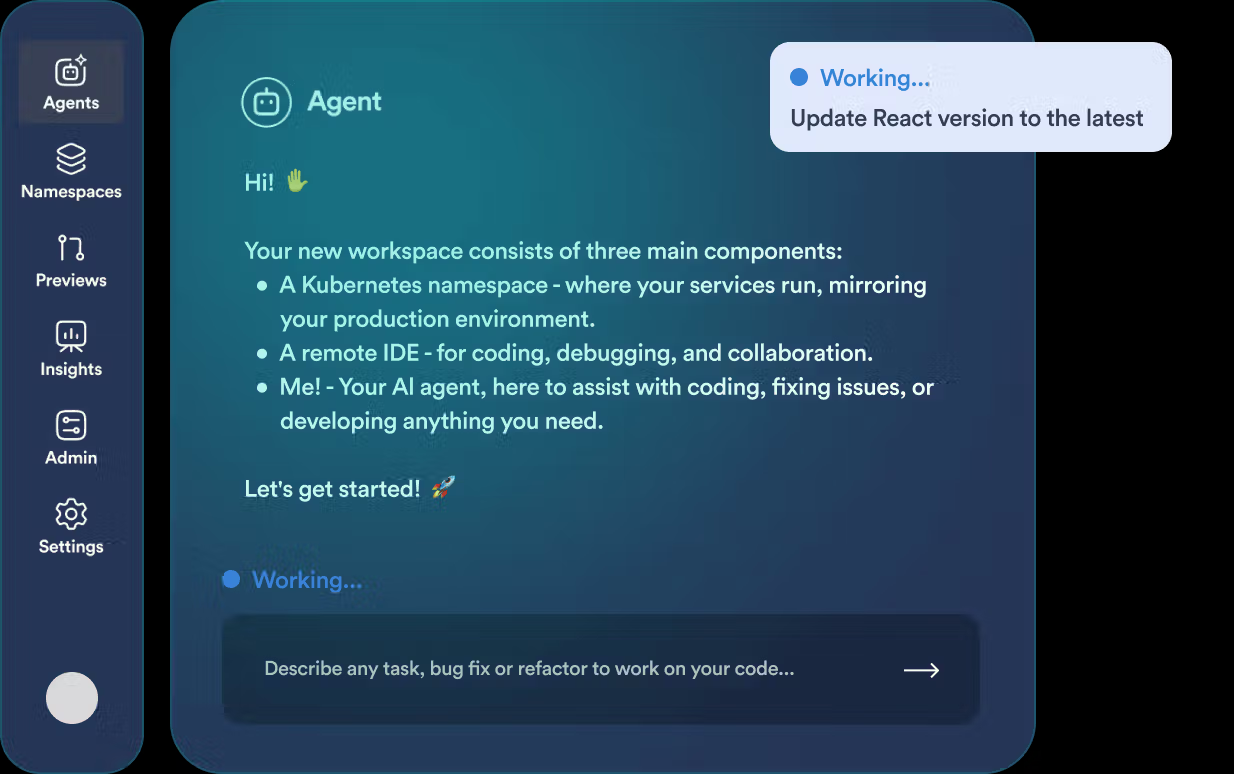Okteto AI is a cloud-based platform designed for AI development that enables developers to run trusted AI agents to rapidly build, test, and deploy code. The platform utilizes Kubernetes to provide isolated temporary environments, ensuring that each AI agent runs in the same configuration as its production counterpart, balancing security and efficiency.Okteto AI supports running multiple agents in parallel, generating complete Pull Requests and shareable preview environments to accelerate development and collaboration. The platform is ideal for teams that need to efficiently develop AI applications, test models, or run complex tasks on their own infrastructure. The Okteto CLI simplifies operations without requiring developers to have a deep understanding of Kubernetes.
Function List
- Provides an isolated temporary environment where AI agents can generate, test and deploy code independently.
- Ensure that development environments are consistent with production environments by automatically loading real configurations and services.
- Supports running multiple AI agents in parallel to quickly test different branches or features.
- Automatically generate Pull Requests and shareable preview environments for easy team review.
- Integrated GPU resources, on-demand, to optimize AI model training and testing.
- Supports real-time code synchronization, local changes immediately take effect in the cloud.
- Automate unit, integration and end-to-end testing to reduce errors.
- Provide security governance, apply permissions and resource restrictions for production environments.
Using Help
Okteto AI is easy to use and you can get started quickly with the Okteto CLI and Kubernetes cluster. The following detailed installation, configuration, and functionality steps will help you get up and running with the platform.
Installation and Configuration
- Installing the Okteto CLI
The Okteto CLI is the core tool for operating Okteto AI and is supported on Windows, macOS and Linux.- Visit the official website (https://www.okteto.com/docs/get-started/install-okteto-cli/) to download the CLI.
- Take macOS as an example, run the following command in Terminal to install it:
curl https://get.okteto.com -sSfL | sh - After the installation is complete, run
okteto versionConfirm the version number to ensure successful installation.
- Connecting a Kubernetes Cluster
Okteto AI relies on Kubernetes clusters to run, either using local Minikube or cloud clusters (e.g. AWS EKS, Google GKE).- assure
kubectlConfigured and able to access the cluster, runkubectl cluster-infoCheck the connection. - Run in the project directory
okteto initThe CLI automatically generatesokteto.ymlconfiguration file that defines the environment requirements.
- assure
- Starting the development environment
- (of a computer) run
okteto upTo create a temporary development environment, the CLI creates a temporary development environment according to theokteto.ymlDeploy containers that are consistent with your production environment. - Local code is automatically synchronized to the cloud, the application is updated immediately after saving the code, and hot reloading is supported.
- (of a computer) run
okteto downClose the environment and free up resources.
- (of a computer) run
Main Functions
- Running a Trusted AI Agent
The core function of Okteto AI is to run an AI agent that generates code usable in a production environment.- Run in the project directory
okteto deployThe CLI is based onokteto.ymlThe environment is deployed and the agent starts performing tasks. - The agent automatically generates code, runs tests and creates Pull Requests, and includes a shareable preview environment.
- Example: One agent generates API code for a Flask application, and another agent runs tests and verifies the results.
- Run in the project directory
- Real-time code synchronization
- utilization
okteto upThe local code is kept in bi-directional synchronization with the containers in the cloud. - Edit the code in a local IDE (e.g. VS Code), save it, and the cloud app is updated immediately, usually within 2-3 seconds.
- For example, modifying the React After the front-end code, the preview environment is automatically refreshed to show the latest results.
- utilization
- automated test
- Okteto supports running unit tests, integration tests and end-to-end tests.
- exist
okteto.ymlDefine the test script in theokteto testExecute the test and the terminal displays the results. - For example, using the
pytestTest AI models to quickly spot potential errors.
- Running multiple agents in parallel
- Supports "Agent Fleets" where multiple agents work on different tasks in parallel.
- exist
okteto.ymlDefine multiple agent tasks in theokteto deploy --fleetLaunch the fleet. - For example, one agent optimizes database queries while another develops new features without interfering with each other.
- Generate preview environment
- Each time you submit a Pull Request, Okteto automatically generates a preview environment. Run
okteto previewCreate shareable links. - Team members access the environment via links to test new features or code changes.
- Integrate with GitHub Actions to automatically trigger tests and generate feedback.
- Each time you submit a Pull Request, Okteto automatically generates a preview environment. Run
- GPU Resource Support
- Okteto AI offers dynamic GPU allocation for training large AI models.
- exist
okteto.ymlSpecify the GPU requirements in theokteto deployAllocate resources. - For example, training Transformer The platform automatically allocates GPUs to optimize performance when modeling.
Featured Function Operation
- Production environment consistency
- Okteto AI ensures that the development environment is fully aligned with the production environment, including configurations, dependencies, and services.
- (of a computer) run
okteto upThe CLI automatically loads the ConfigMap and Secrets of the production environment. - Developers don't need to worry about the "local normal, production failure" problem.
- Abstract infrastructure complexity
- The AI agent automatically generates deployment manifests and Docker Compose files to simplify Kubernetes configuration.
- (of a computer) run
okteto scaffoldRapidly generate multi-service application frameworks, including test scripts. - For example, generate an application template that contains a front-end, back-end, and database.
- Security and governance
- Each agent environment is isolated sandboxed to prevent data leakage and is SOC 2 Type 2 compliant.
- Configure RBAC through the Admin Dashboard to restrict access to the environment.
- For example, developers can only access their own agent environment and cannot modify the production configuration.
caveat
- Ensure that the Kubernetes cluster has sufficient resources to support multiple agent environments.
- Periodically shut down unused environments and run
okteto downRelease of resources. - Enterprise users can upgrade to Okteto Enterprise at https://www.okteto.com/pricing for advanced features such as GitOps.
- More tutorials and examples can be found in the official documentation: https://www.okteto.com/docs/.
application scenario
- Rapid development of AI applications
Development teams need to quickly build AI-driven applications such as chatbots.Okteto AI provides an isolated environment where agents automatically generate code and tests to accelerate development. - Parallel testing model variants
Data scientists need to test AI models with different hyperparameters.Okteto AI supports running multiple agents in parallel, each testing a model variant, providing GPU support and test feedback. - Teamwork and Code Review
Development teams want to quickly validate features as they commit code.Okteto AI automatically generates preview environments that team members can link to to test new features and improve collaboration. - Enterprise self-hosted AI development
Organizations need to develop AI applications on their own infrastructure to meet compliance requirements.Okteto AI supports self-hosted Kubernetes clusters to ensure data security.
QA
- Does Okteto AI need Kubernetes experience?
No. The Okteto CLI simplifies Kubernetes operations, allowing developers to deploy environments by running simple commands. - How do I ensure that the AI agent generates code reliably?
Agents run in production-consistent isolation, automatically testing every change to ensure code quality. - What programming languages and frameworks are supported?
Support for major languages and frameworks (e.g. Python, Node.js, Go) is available through theokteto.ymlCustomize the environment. - How do I access the preview environment?
(of a computer) runokteto previewGenerate links through which team members can access the test environment without additional configuration. - Does Okteto AI support native development?
Support. Native code is passed through theokteto upSynchronized to the cloud, developers can continue to use the local IDE.


































